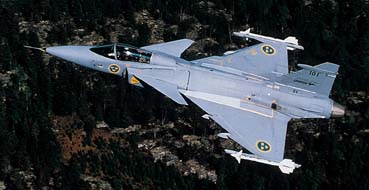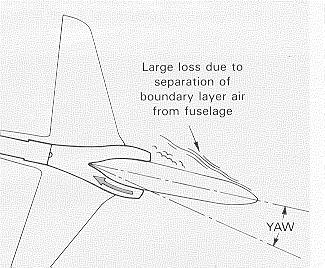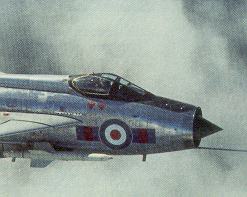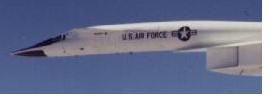 |
At subsonic speeds, the ideal inlet is a "pod" or "pitot" installation,
as seen on most modern jetliners. This makes full use of the "ram effect" and
has minimum size, weight, and effect on the aircraft's aerodynamics. |
 |
For smaller single-engine aircraft, a pod generally isn't feasible. Instead,
the usual practice is to bury the engine in the fuselage and have one or more
intakes on the top, bottom, or sides. Most military jet trainers and many
front-line fighters like the F-16 use such an installation. The problem is
that if the aircraft manuevers "away from the duct" (due to yaw or angle of
attack) the airflow in the duct is much decreased due to separation.
|
 |
|
Neither of these types of inlets do well at higher supersonic speeds, due to
shockwaves that form on the lip of the inlet, reducing the efficiency of the
inlet. |
 |
At lower supersonic speeds, one type of inlet to use is an
internal/external compression intake, which produces a series of mild shock
waves to reduce flow speed to subsonic without much energy loss. |
 |
At higher supersonic speeds, due to the nature of shock waves, the best
inlet must have a variable geometry. These often produce one or several
oblique shocks, as well as a normal shock, to reduce the flow to subsonic
speed. They also have the ability to aid in compresion, and in the case of
a ramjet do ALL the compression. Examples of this kind of inlet can be found
on the F-15, the Concorde, and many other aircraft. |

|
One other type of variable-geometry supersonic nozzle combines the
internal/external compression nozzle with a mobile cone to achieve a
similar effect. Nozzles of this type can be found on several older
Soviet fighters like the MIG-21, as well as on the SR-71 Blackbird. |
 Back to the Purdue AAE Propulsion main page.
Back to the Purdue AAE Propulsion main page.
 Back to the Turbine Engine Basics page.
Back to the Turbine Engine Basics page.
 Back to the Purdue AAE Propulsion main page.
Back to the Purdue AAE Propulsion main page.
 Back to the Turbine Engine Basics page.
Back to the Turbine Engine Basics page.






 Back to the Purdue AAE Propulsion main page.
Back to the Purdue AAE Propulsion main page.
 Back to the Turbine Engine Basics page.
Back to the Turbine Engine Basics page.